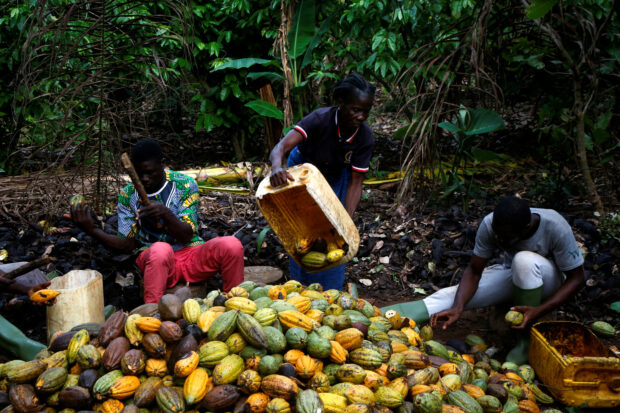
Farmers break cocoa beans at a farm in Sinfra, Ivory Coast April 29, 2023. REUTERS/Luc Gnago/File photo
SINGAPORE – Cocoa and iron ore prices surged in 2023, while natural gas and coal prices tumbled, with most agricultural products expected to outperform energy and industrial metals in the New Year amid supply constraints and dry weather.
The Thomson Reuters/CoreCommodity CRB Excess Return Index, which includes more than a dozen commodities such as oil, gold, sugar and copper, is set to fall 4 percent for 2023 after interest rate hikes dampened global growth and shook financial markets.
Cocoa prices rose 72 percent to multi-decade highs because of constrained supplies and iron ore was up nearly 55 percent as China looked to shore up its property sector.
But the prices of natural gas and coal tumbled from 2022’s record highs after Russia’s invasion of Ukraine and were among the biggest losers as producers ramped up supplies and demand eased.
“A warm start to this winter has kept prices deflated so far, and if it remains warm as forecast, most regions will be able to tide through this winter comfortably, with even more to spare for next year’s winter,” said Rystad energy analyst Lu Ming Pang.
Macquarie analysts said in a note they expect aggregate commodities price weakness to continue in 2024, with U.S. economic growth to soon stall and European and Chinese growth likely to remain tepid at best.
Standout performers
New York cocoa futures rose to a 46-year high this year and are expected to remain strong in 2024, buoyed by a poor harvest in the key producing region, West Africa, where the spread of viral swollen shoot disease has hit crops.
Capital Economics said in a note that constrained supply combined with high seasonal demand was likely to support high cocoa prices through 2024 until new supply arrives in October, the start of the next growing season.
For iron ore, efforts by China to revive its beleaguered property sector and shore up a patchy post-pandemic economic recovery boosted prices, with more gains expected in early 2024.
READ: China vows to support property sector, tackle local debt
“Supportive policies on the property market, coupled with expectations on further economic stimulus during the top decision-making meetings in December acted as tailwinds,” said Pei Hao, a Shanghai-based analyst at brokerage FIS.
Food supply shocks
Hot and dry weather due to El Nino has taken a toll on global rice, coffee and sugar production, supporting prices.
Supply shocks in the rice market prompted India, the biggest supplier globally to restrict exports, driving prices of the world’s most widely consumed staple to 15-year highs and triggering food inflation pressure.
READ: UN warns world to prepare for El Niño impact
Rice prices in Asia’s key exporting centers have climbed more than 40 percent in 2023 and adverse weather is expected to further reduce output early next year.
Shrinking supplies also triggered a rally in coffee prices with robustas gaining almost 60 percent in 2023.
Sugar production in India is set to lag consumption for the first time in seven years and lower plantings could force the world’s No.2 producer to turn into a net importer.
Wheat, corn and soybeans are headed for losses in 2023, but prices remain vulnerable to adverse El Nino weather, export restrictions and higher biofuel mandates.
Palm oil production is likely to fall next year due to El Nino, supporting cooking oil prices that dropped more than 10 percent in 2023.
Rising energy supply
Rising oil, gas and coal supply could weigh on prices for a second year in 2024.
Brent and West Texas Intermediate (WTI) crude futures are down around 7 percent this year, falling for the first time in three years, despite record global oil demand and deeper supply cuts from OPEC+.
Non-OPEC production growth is set to dominate in 2024, with S&P Global Commodity Insights forecasting record crude and liquids production in the U.S., Brazil and Canada.
READ: OPEC faces declining demand and shrinking market share in early 2024
Macquarie expects Brent and WTI prices to average at $77 and $73 a barrel in 2024.
Asia spot liquefied natural gas and Australia Newcastle coal futures tumbled more than 50 percent from last year’s record highs, as demand from Europe eased while China and India ramped up coal output to prevent a repeat of last year’s energy shock.
Mixed outlook for metals
A softer U.S. dollar and Treasury yields amid growing expectations that the Federal Reserve will end its monetary policy tightening helped gold race towards its best year in three and saw prices scale all-time highs above $2,100 this month.
Citi expects gold and silver prices to rise by mid-2024 on strong demand for the metals as a hedge against downside risks in developed market equities and property.
READ: Gold hits record high as equities weaken
For industrial metals, nickel, down more than 40 percent in 2023, was the biggest loser, pressured by higher supplies in top producers Indonesia and China.
Prices are expected to remain under pressure in 2024 amid a global surplus for the metal used in stainless steel and electric vehicle batteries.
Softer-than-expected Chinese demand and U.S. interest rate hikes weighed on prices, which recovered some ground in recent months due to supply disruptions by mine closures in Panama.